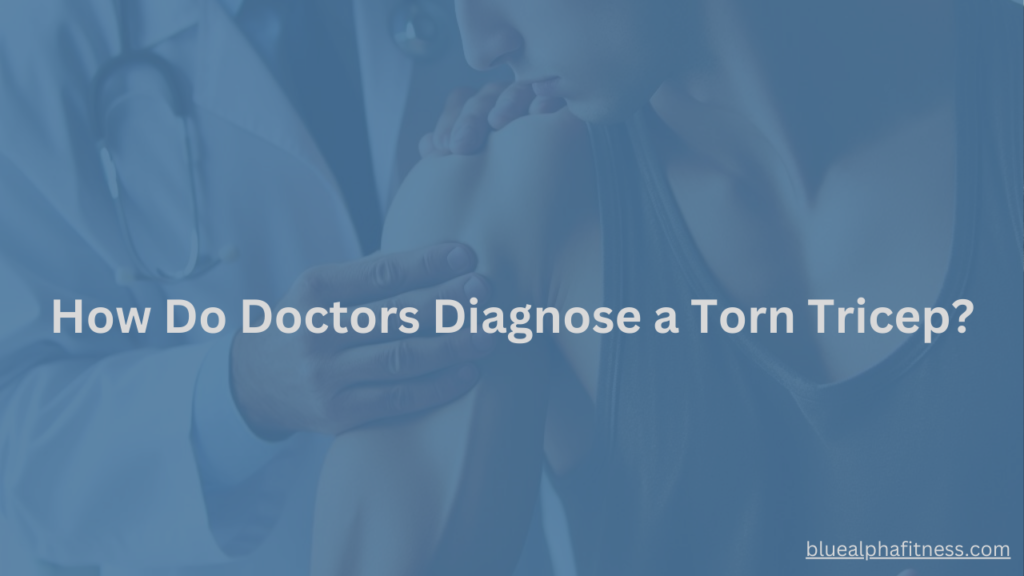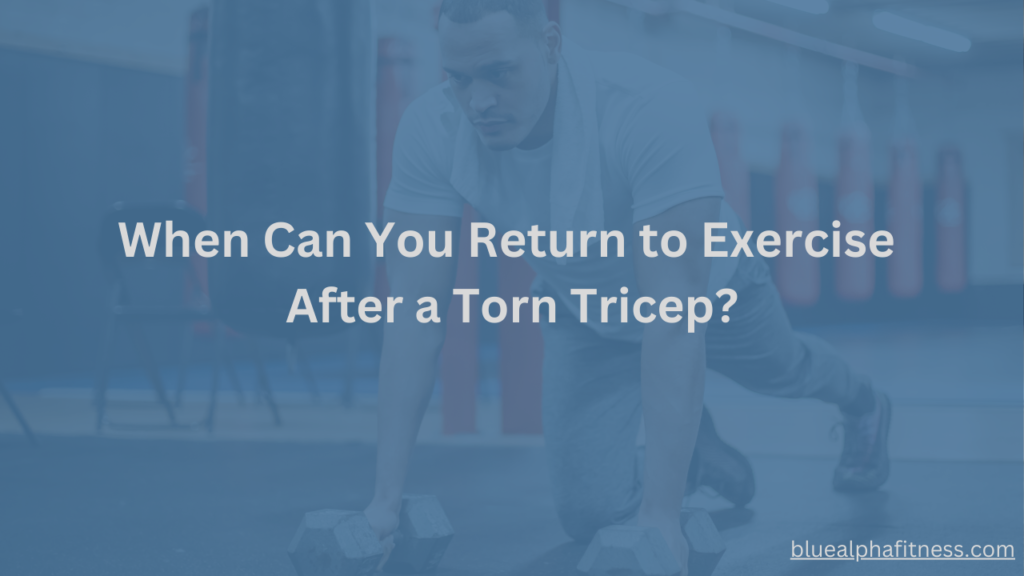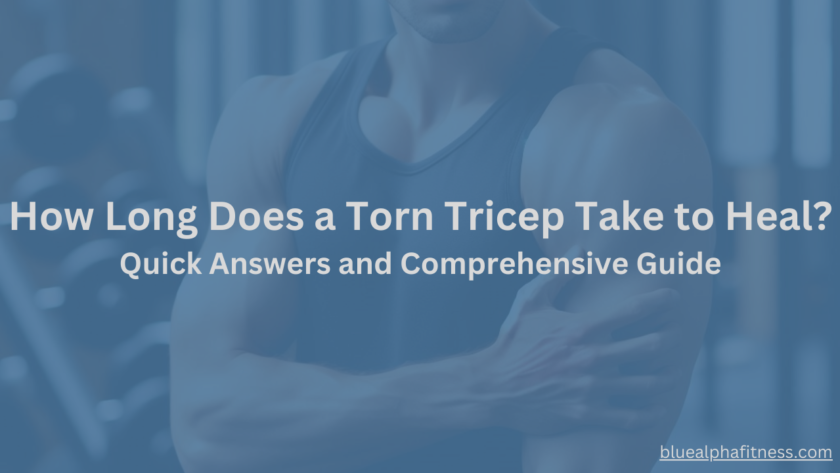If you’re wondering how long it takes for a torn tricep to heal, you’re probably feeling frustrated, in pain, and tired of waiting.
A torn tricep can feel like a huge setback, especially if you’re used to pushing your limits.
Maybe you’re anxious to lift again or just want to move your arm without wincing. It’s tough—injuries like this don’t just affect your body; they can zap your motivation too.
So, how long does a torn tricep take to heal? It depends on the severity. A mild tear might take 4-6 weeks, while a more serious injury could take months.
But don’t worry—this article will walk you through the recovery process and offer clear steps to speed up healing.
Ready to start feeling better?
Let’s dive in.
How Long Does a Torn Tricep Take to Heal? Detailed Explanation
As mentioned earlier, how long it takes for a torn tricep to heal can vary significantly—anywhere from about 4 weeks to several months—depending on the severity of the injury.
Let’s dive into the factors that influence your healing period and explore the general timelines.
Key Factors That Affect Torn Tricep Recovery Time
Factors that affect torn tricep recovery time include the severity of the tear, your overall health, and your commitment to rehabilitation.
Let’s dive deeper into each factor.
1. Severity of the Tear
The bigger the tear, the longer it takes to heal—pretty straightforward, right?
A mild tear (Grade 1) may heal relatively quickly, while more severe tears (Grade 2 and Grade 3) take longer, particularly if surgery is involved.
2. Age
Age plays a big role in recovery.
The younger you are, the more quickly your body tends to bounce back.
Older individuals might experience slower tissue repair due to reduced collagen production and blood flow.
If you’re in your 50s or 60s, you may need to give yourself a little extra time compared to a younger athlete.
3. Overall Health
If you’re in good health overall—strong cardiovascular system, no chronic diseases, good nutrition—you’ll heal faster.
Conversely, if you’re dealing with conditions like diabetes or poor circulation, the healing process can slow down.
It’s like trying to drive with a flat tire—you’re moving, but at a slower pace than you’d like.
4. Adherence to Rehabilitation
Healing isn’t passive.
If you’re not fully engaged in your physical therapy, you’ll see delays.
But if you’re committed to rest when needed and put in the work during rehab, your body will respond more quickly.
Rehab isn’t just about strength; it’s about retraining your muscle fibers and restoring function.
Healing Timelines for a Torn Tricep: Mild, Moderate, and Severe Injuries
Let’s break down the general timelines you can expect based on the severity of your tear.
1. Mild Tear (Grade 1)
With a mild tear, you might feel some discomfort, but your muscle is still largely intact.
Pain and tenderness are common, but the damage is limited to overstretched muscle fibers. Healing for this kind of tear can take anywhere from 2 to 6 weeks.
During this period, rest, ice, compression, and elevation (RICE) will be your best friends.
You’ll want to avoid heavy lifting or overuse of the arm, but gentle movements will keep the muscle active without causing further damage.
2. Moderate Tear (Grade 2)
A moderate tear is more serious and involves a partial tear of the muscle.
You’ll experience more significant pain, swelling, and weakness. Bruising might appear due to bleeding under the skin.
With proper care, recovery can take 6 to 12 weeks.
Physical therapy becomes a key part of your recovery, helping you regain strength and mobility.
3. Severe Tear (Grade 3)
A severe tear, or complete rupture, is when the muscle fully tears away from the tendon or bone.
This is a devastating injury that typically requires surgery.
Post-surgery recovery can take 4 to 6 months before you’re back to normal.
Although the process may seem daunting, with patience, proper rehab, and the right care, you can regain full use of your arm.
What Are the Common Symptoms of a Torn Tricep?
The common symptoms of a torn tricep include pain and tenderness, swelling, bruising, and difficulty extending the arm.
These symptoms can range from mild to severe, depending on the injury’s extent.
Let’s dive deeper into each symptom and what they mean for your recovery.
1. Pain and Tenderness
The most obvious sign is pain.
With a mild tear, the pain might be dull, more like a muscle strain. But with a moderate or severe tear, the pain can be sharp, making it difficult to move or use your arm.
2. Swelling
Swelling is common and often immediate.
Your body sends blood and fluids to the site of injury to help with healing, but it also causes puffiness in the area.
3. Bruising
Depending on the severity, bruising may appear, especially in the case of a moderate or severe tear.
This happens because the blood vessels in the muscle rupture along with the tissue, leading to visible discoloration.
4. Difficulty Extending the Arm
A torn tricep makes it difficult to fully extend your arm, and you may notice weakness, especially during pressing or pushing movements.
You might even find that simple tasks like pushing open a door become challenging.
How Do Doctors Diagnose a Torn Tricep?
Doctors diagnose a torn tricep through a physical examination and imaging tests like MRI or ultrasound. These methods help determine the severity of the injury and guide the best treatment plan.

Here’s how each of these steps works in the diagnosis process.
· Physical Examination
Doctors will start with a physical exam, pressing on the injured area to check for tenderness, swelling, and range of motion.
They’ll ask you about how the injury happened and what symptoms you’re experiencing.
· MRI or Ultrasound
If the doctor suspects a more serious tear, imaging tests like an MRI or ultrasound might be necessary.
These scans give a detailed view of the soft tissue, helping to identify the extent of the injury.
An MRI is particularly good for showing whether the tear is partial or complete.
How Long Does It Take for a Torn Tricep to Heal Without Surgery?
It takes about 4 to 12 weeks for a torn tricep to heal without surgery, depending on the severity of the tear. Most minor to moderate tears can recover well with non-surgical treatments if you follow the right steps.
Let’s explore what to expect during the recovery process.
For a mild to moderate tear, treatment typically involves the RICE method:
· Rest: Resting the muscle gives it time to repair.
· Ice: Using ice can minimize inflammation and ease pain
· Compression: Applying compression helps control inflammation.
· Elevation: Elevating the arm can further help in reducing swelling.
Physical Therapy:
As the injury begins to heal, physical therapy becomes crucial.
The process usually includes:
- Gentle Exercises: Start with exercises to restore range of motion.
- Strength-Building: Progress to exercises that build strength in the tricep and surrounding muscles.
This process can take anywhere from 4 to 12 weeks, depending on the severity of the injury.
Important Tip:
During this time, it’s important to avoid rushing back to activity.
Your body needs time to fully recover, and pushing too soon can result in re-injury.
Think of it like trying to bake a cake without letting it fully rise—you’ll end up with a mess instead of the result you want.
How Long Does It Take for a Torn Tricep to Heal After Surgery?
It takes about 3 to 6 months for a torn tricep to heal after surgery, depending on the tear’s severity and rehab progress.
Recovery includes rest, then physical therapy to restore strength and mobility.
Here’s what to expect during each stage of recovery.
1. Immediate Post-Surgery Period
In the first few weeks following surgery, you’ll likely wear a sling or brace to keep your arm immobile. This is essential for protecting the repair and preventing further injury.
Pain and swelling are expected during this time, but your doctor will give you pain management strategies.
2. Rehabilitation Phase
Once the initial recovery period is over, physical therapy becomes the focus.
You’ll start with gentle stretches to regain range of motion, followed by strengthening exercises.
This part of recovery can take 3 to 6 months or longer, depending on the severity of the injury and how your body responds to rehab.
3. Return to Normal Activities
After several months of physical therapy, you’ll gradually return to normal activities.
That said, it’s crucial not to push yourself too hard.
Jumping back into weightlifting too soon can cause further damage, so be patient and follow your therapist’s advice.
What Are the Best Treatments for a Torn Tricep?
When it comes to treating a torn tricep, you have two main options: conservative treatment or surgery.
· Conservative Treatment (for Mild to Moderate Tears)
As mentioned, RICE is often the first step in treating a torn tricep.
Resting the muscle is key, but that doesn’t mean complete immobility.
Gentle range-of-motion exercises, like wrist flexion and extension or elbow bends, can keep the muscle from stiffening.
After a few days, physical therapy will help restore strength and function, typically starting within 1-2 weeks.
Pain and swelling can also be managed with anti-inflammatory medications
If pain persists or worsens, consult a physician to reassess your treatment plan.
· Surgery (for Severe Tears)
Surgery is typically reserved for Grade 3 tears, where the muscle has completely ruptured.
During surgery, the muscle is reattached to the tendon or bone.
The recovery process is extensive and can take several months, with physical therapy starting shortly after surgery to regain mobility and strength.
Following surgery, it’s crucial to adhere to your rehabilitation plan for the best chance of a full recovery.
How Can You Speed Up Recovery from a Torn Tricep?
You can speed up recovery from a torn tricep by focusing on proper nutrition, getting enough rest and sleep, sticking to your rehab plan, and listening to your body.
These strategies can help ensure a smoother, more efficient healing process.
Let’s see how each of these can make a difference.
1. Proper Nutrition
Your body needs fuel to repair muscle tissue, and a diet rich in protein, healthy fats, and vitamins is essential.
Aim for 1.2-2 grams of protein per kilogram of body weight to support muscle repair.
Lean meats, fish, eggs, and plant-based options like legumes are great choices.
Omega-3 fatty acids (found in fish like salmon or chia seeds) can reduce inflammation, while Vitamin C (citrus fruits, berries) aids in collagen production, which is crucial for tissue healing.
2. Rest and Sleep
Sleep is when your body does most of its healing, producing growth hormones that aid in muscle repair.
Strive to get 7-9 hours of restful sleep each night.
During the day, avoid activities that could strain your tricep, such as lifting heavy objects or movements that cause discomfort.
Instead, focus on gentle range-of-motion exercises recommended by your therapist to keep circulation moving without causing strain.
3. Follow Your Rehab Plan
Stick to the exercises your physical therapist gives you, but don’t overdo it.
Rehab exercises typically start with gentle stretching and progress to isometric holds before moving into eccentric strengthening exercises (where the muscle lengthens under tension).
Following the plan helps rebuild strength gradually and minimizes the risk of re-injury.
4. Listen to Your Body
If something feels off, take it seriously.
Pain is your body’s signal that something isn’t right.
If you experience sharp pain or swelling during exercises, stop immediately and consult with your healthcare provider or physical therapist.
Overlooking these signs can lead to complications like scar tissue formation, which could prolong recovery.
When Can You Return to Exercise After a Torn Tricep?
You can return to exercise after a torn tricep when your physical therapist gives you the go-ahead, but it’s crucial to start slow and gradually build strength.

Let’s break down how to safely reintroduce exercise into your routine.
1. Start Slowly
Initially, stick to light, low-impact activities.
Walking, cycling, and gentle yoga are great options to keep your body moving without placing too much strain on your healing tricep.
The goal here is to maintain mobility and circulation while avoiding stress on the injured muscle.
2. Gradual Strength-Building
When your physical therapist gives you the green light, start incorporating strength exercises that target the tricep.
Begin with light weights or resistance bands, focusing on high repetitions to build endurance.
Gradually increase the load as your muscle strengthens, but don’t rush—let your body guide you.
3. Avoid Overexertion
Patience is key.
Overdoing it, especially early on, is a recipe for setbacks. Focus on perfecting your form, and prioritize quality over quantity.
Pushing too hard can cause reinjury, setting you back weeks, if not months.
4. Include Stretching and Mobility
While building strength, don’t forget to stretch and maintain mobility.
Incorporating flexibility exercises into your routine can help prevent stiffness and improve muscle recovery.
5. Monitor Pain Levels
If you feel sharp pain or swelling during or after exercises, stop immediately and consult your physical therapist.
Minor discomfort is normal, but pain is your body’s way of signaling something’s wrong.
How Long Does It Take for a Torn Tricep to Heal? Answers to Your Common Questions
Now, let’s address the most common questions regarding the recovery time for a torn tricep.
1. Can a torn tricep heal on its own?
A torn tricep can heal on its own if it’s a minor tear. Severe tears usually require medical intervention for full recovery.
2. How long does it take for triceps to fully recover?
It takes about 3 to 6 months for triceps to fully recover, depending on the severity of the injury and adherence to rehabilitation protocols.
3. How long does it take for tricep pain to go away?
It takes 2 to 4 weeks for tricep pain to go away for mild strains. Severe tears may take longer, especially if they require surgery.
4. How long does tricep pain last?
Tricep pain can last from a few days to several weeks, depending on the injury’s severity and the effectiveness of treatment.
5. What happens if you don’t repair a torn tricep?
If you don’t repair a torn tricep, it can lead to chronic weakness, limited arm function, and possible deformity.
6. What happens if you don’t repair a torn tricep tendon?
If you don’t repair a torn tricep tendon, you may experience a permanent loss of strength and difficulty extending your arm.
7. What is the success rate of tricep tendon surgery?
The success rate of tricep tendon surgery is around 80% to 95%, with most patients regaining significant strength and function.
8. How much does torn tricep surgery cost?
Torn tricep surgery costs range from $5,000 to $15,000, depending on location, surgeon fees, and hospital charges.
9. How to prevent tricep tears?
You can prevent tricep tears by warming up properly, avoiding overuse, and incorporating strength training exercises that target the triceps.
10. What is the most common tricep injury?
The most common tricep injury is a strain or partial tear, often caused by overuse or lifting heavy weights.
11. What is the difference between a bicep tear and a tricep tear?
The difference between a bicep tear and a tricep tear is the location; a bicep tear affects the front of the upper arm, while a tricep tear affects the back.
12. How rare is a tricep tear?
Tricep tears are relatively rare compared to other muscle injuries, making up a small percentage of all tendon ruptures.
13. Can a torn tricep cause shoulder pain?
A torn tricep can cause shoulder pain due to compensatory movement and muscle imbalances.
14. How do you stretch a torn tricep?
You should stretch a torn tricep gently by extending your arm overhead and bending the elbow, using the opposite hand to support a light stretch.
15. What does a partially torn tricep look like?
A partially torn tricep may show bruising, swelling, and a visible dip or indentation in the muscle.
16. Why does my tricep hurt when I bend my arm?
Your tricep may hurt when you bend your arm due to muscle strain, inflammation, or a minor tear.
17. How do I know if my tricep is torn?
You may know your tricep is torn if you experience sudden pain, swelling, bruising, and difficulty extending your arm.
18. What does a tricep injury feel like?
A tricep injury feels like sharp or dull pain at the back of the arm, often accompanied by tenderness, swelling, and weakness.
19. Does a torn tricep heal faster without surgery?
A torn tricep can heal faster without surgery if the tear is mild to moderate and proper recovery protocols, such as rest and physical therapy, are followed.
20. What can delay the healing of a torn tricep without surgery?
Factors like inadequate rest, skipping physical therapy, or returning to activities too soon can delay the healing process of a torn tricep without surgery.
Your Road to Recovery from a Torn Tricep
By now, you’ve probably realized that healing a torn tricep isn’t a quick fix.
It’s natural to feel impatient—maybe you’re thinking, “When can I finally move without pain or hit the gym again?”
That’s real, and it’s frustrating.
But here’s the thing: you’ve already taken the first step by understanding what you’re up against.
This article has given you the knowledge you need—clear timelines, recovery tips, and insight into the healing process.
You’re not just passively waiting for your body to recover; you’re actively working toward your comeback.
Every small win, every bit of progress, is a sign that you’re getting closer.
So, keep your head up. Healing takes time, but you’re tough, and with the right mindset, you’ll come out stronger.
Your tricep might heal in stages, but the determination you build now? That lasts forever.
Keep pushing. You’ve got this.



